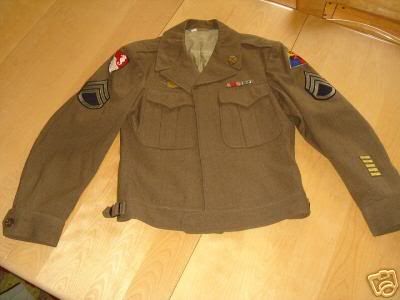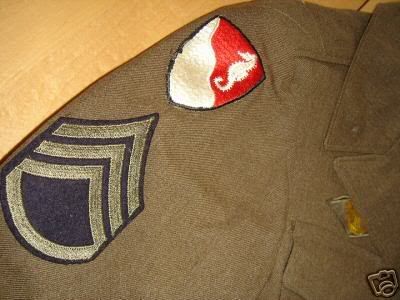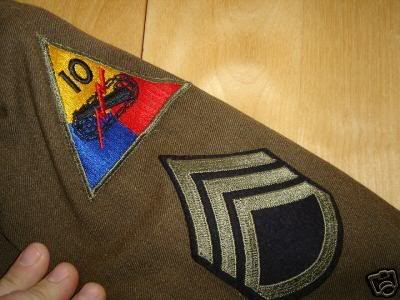I sent requests for info to several of my guys and also consulting some documentation. The following was taken from websites...
---------
*On the right sleeve of the Class A blouse was worn the rank.
*On the left sleeve of the Class A blouse were worn the following: Organizational patch of the unit he was serving with at the time (removed if the "Ruptured Duck" insignia worn on the uniform), rank, overseas stripes, and then the service stripes.
*On the Class A blouse right upper lapel was worn the one-inch brass USA disc.
*On the Class A blouse left upper lapel was worn the one-inch brass disc that was their branch insignia.
*On the Class A blouse right and left lower lapel were worn the Distinctive Insignia or DIs. This indicated the smaller unit that was part of the larger unit in which he was serving.
*References are: World War II Order Of Battle by Captain Shelby L. Stanton, U.S. Army Special Forces (Retired) and Finding Your Father's War: A Practical Guide To Researching And Understanding Service In The World War II U.S. Army by Jonathan Gawne
---------
Here's another reference:
Unit Patches - During WWII, patches were made of cotton twill, wool felt, leather, or bullion, and can be embroidered, printed or painted. An original patch with white thread will not glow under a black light (all natural fibers), and is often identified by a "cut edge". Modern embroidered patches are made using a machine that requires a full edging process, and often have a little embroidered chain "tail" that hangs off the side. Reproduction felt, leather, and bullion patches also exist, and are sometimes much harder to tell from the original, and are sometimes being made with vintage materials. (Bullion is a gold or silver metallic coil that is cut into tiny pieces and hand or machine stitched into a design). Original patches can run from $3-$5 for a common embroidered unit patch to $100's or $1,000's for a rare theater made bullion or leather made patch. Note: Class A's, ETO uniforms (Ike and trousers) and A-2 flight jackets are the only times when it's really appropriate to deviate from the standard embroidered patch. Otherwise, with patches, less is more. Many units did not wear patches at all on their HBT's.
The active unit goes on the left shoulder of your uniform, your former or combat unit is on the right, although if you are putting together a uniform for an impression, the former unit was not always practiced, and most often was a sign of someone who had served overseas or in combat, so it is advised that you not wear a second unit on your other sleeve.
Overseas bars - one for each 6 months of service, sewn on the cuff of class A uniforms
------------
![]() This is the second 36th Ike jacket in the last couple of years on ebay that had a 10th Armored patch on the other sleeve. Dad said they were fueling up tanks for Patton when they got called back to the Bulge. I think his Ike jacket had a 3rd Army patch on it if I remember right. Any way it was a size 36 r ( same as Dad's) and It might have fit me in junior high school.
This is the second 36th Ike jacket in the last couple of years on ebay that had a 10th Armored patch on the other sleeve. Dad said they were fueling up tanks for Patton when they got called back to the Bulge. I think his Ike jacket had a 3rd Army patch on it if I remember right. Any way it was a size 36 r ( same as Dad's) and It might have fit me in junior high school.

